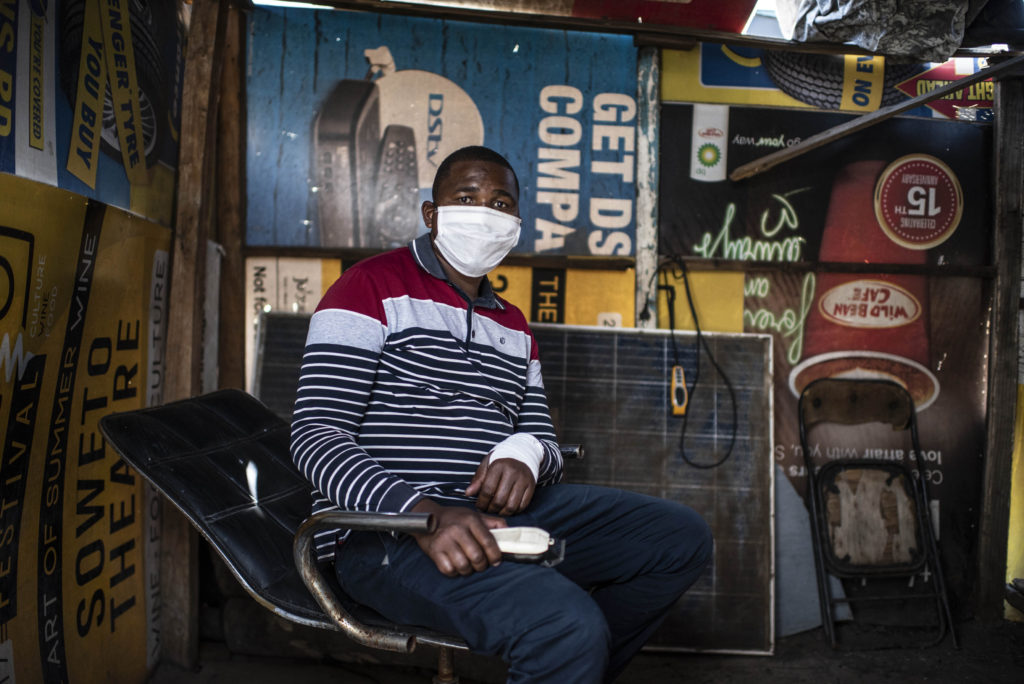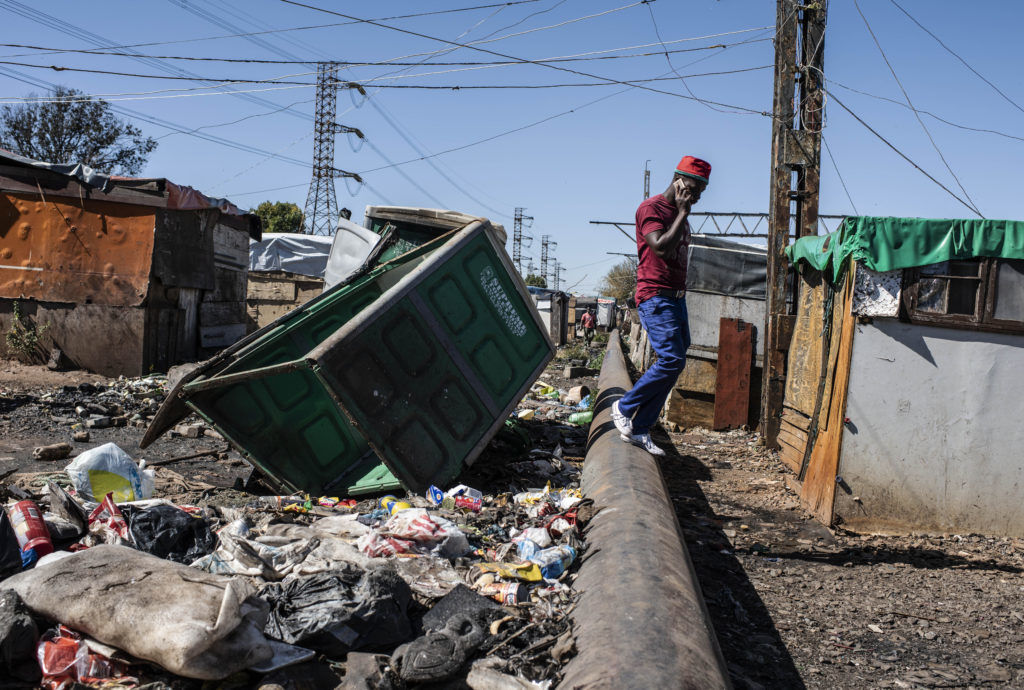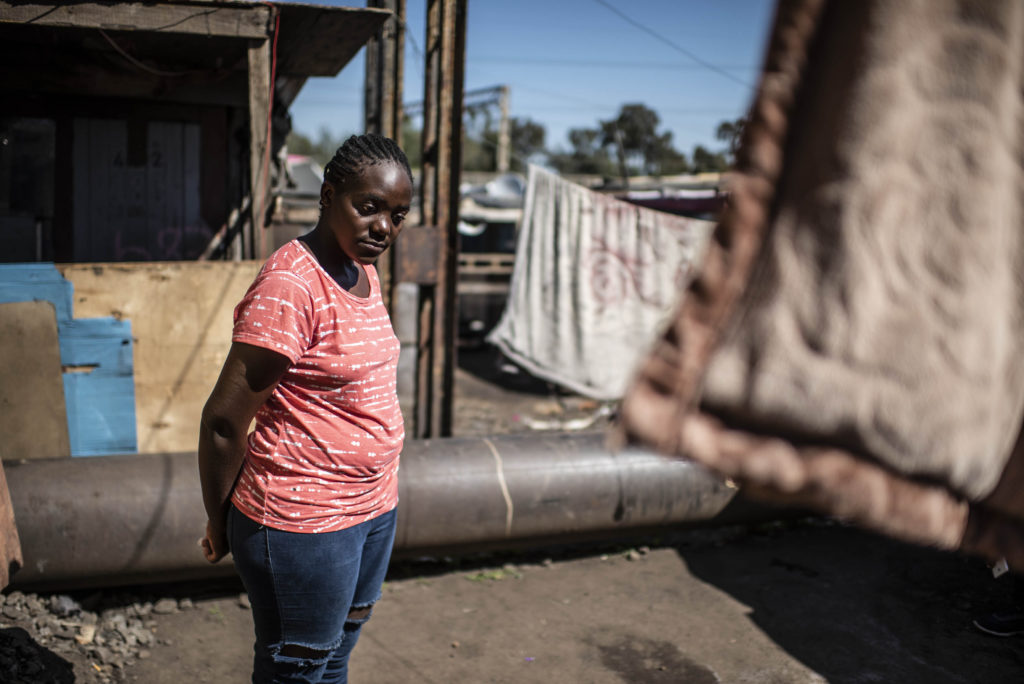Trying to survive: Busungani Sithole (above) was protesting because people in Booysens had no food; after the protest, at which residents were shot with rubber bullets. (Paul Botes/M&G)
Talking to people who live in the Booysens informal settlement, it is hard to tell what has been more brutalising; the metro police’s rubber bullets — whose lesions still mark the faces, backs and legs of residents — or the fact that they have resorted to finding food in the nearby rubbish dumps.
The two seem intricately intertwined. Excessive use of force by the security forces during the Covid-19 pandemic has overwhelmingly been experienced in poor communities. And it was hunger — a demand for food parcels — that brought the Booysens community to its mass action on April 28, which resulted in a violent suppression by the police.
Busungani Sithole has lived in the Booysens informal settlement since 2006: “This is how we ended up getting rubber bullets. It’s not like we were causing havoc. We didn’t do anything wrong. We just wanted the attention of the councillor about something that’s very important to us. Maybe he didn’t see it as important — that we haven’t eaten while we are inside; we’ve got children inside who also haven’t eaten. And no one has come to check on us,” she says. “We’re scared that this will last until the end of season two [referring to level four of the lockdown] … And even the place where we live, locked in, is so dirty that not even a pig could live there. And this is why we ended up coming here.”
 Legal action: Thembelani Zwana is collecting names of people who were injured by the JMPD. (Paul Botes/M&G)
Legal action: Thembelani Zwana is collecting names of people who were injured by the JMPD. (Paul Botes/M&G) Residents have complained about the state of the toilets for years. (Paul Botes/M&G)
Residents have complained about the state of the toilets for years. (Paul Botes/M&G)
The corner where we stand on Eloff Street Extension still bears the marks of the clash. The street leads from Eloff Street, a main road in Johannesburg’s city centre, into the industrial area of Selby.
Rubber bullet casings lie — dirty now — mingled with other detritus. A squeezed-out tube of toothpaste, mangled blue rubber gloves — the new trash of the Covid-19 era — and some autumn leaves.
Thembelani Zwana and other community leaders have been collecting the names of people who were injured and the details of their injuries after the protesting crowd was shot at by officers from the Johannesburg Metropolitan Police Department (JMPD). The list now nears 50 and will be handed to lawyers, they say.
It was the South African Police Service (SAPS) that arrived first, says Aaron Magatsela. He was one of the representatives chosen by the community to negotiate with the police. “I told the constable, before the captain, our issues. And he understood. And then he called the public-violence captain from John Vorster … So he told us he’s not going to shoot at us. And he instructed the SAPS to put their guns away.”
But as they were talking, “the JMPD came, and parked their Quantum, their two Quantums, and one van. And they started to load their guns while we were busy talking with the captain, and they came to him and to approach us here. And the captain told him that we are busy and they must put their guns away”.
The JMPD members told the captain “he must open a case for us or arrest us. Then the other guy from JMPD told me to tell the people to disperse.”
Magatsela says they had five minutes. “While I was trying to go to the people — about three steps — he started shooting at them. The people ran [in] different directions. And the police were trying to say to the JMPD to stop.”
Who actually runs the show during joint operations is an issue that has come up elsewhere. In the court case between the family of Collins Khosa, who died a month ago, allegedly at the hands of the army and JMPD, the Khosa family argued that it was unclear in law who was in charge.
The JMPD did not respond to questions from the Mail & Guardian about who in law would be in charge before the time of going to print. It also did not answer questions about the alleged brutality and the excessive use of force.
At some point, members of the crowd began to throw stones, but Zwana insists that this happened after the police started shooting.
“They started shooting randomly at us. That’s when I got shot, here.” He points to small lesions on his face, one dangerously close to his eye.
“As soon as people turned their backs they started driving us with bullets, including the representatives, all of us. We were leaving when we were shot at,” Zwana says. “Others were shot while inside. They went inside the shacks, they confronted us there; the gentleman over there in grey — he was shot inside his shack, on the foot.”
Nomsa Ncube fell as she was trying to run away; she was trampled on by others. “And then the police came and they shot me here at the ankle, here at the back,” she points at lesions on the back of her leg. “And people were moving upon me. So that’s why I got injured. And it’s very, very painful.”
Magatsela says that as people ran, some dropped their phones and ID books. Police officers picked these up and threw them into the fire made by the burning tyres. “It felt … personal,” he says.
Asked why she had joined the protest, Ncube says: “Food. Food parcels.”
There were two streets on which Booysens residents gathered to protest. Both lead off Eloff Street Extension into the informal settlement that houses “maybe 10 000” people, says Zwana. Many of them are recyclers — they earn money by selling to scrap yards.
 Injured: Nomsa Ncube was shot in the ankle as people were trying to disperse when the police began shooting. (Paul Botes/M&G)
Injured: Nomsa Ncube was shot in the ankle as people were trying to disperse when the police began shooting. (Paul Botes/M&G)
“After the lockdown came, the scrapyards were closed. Now our funds, our little resources, were exhausted. People began now to collect food from the dumping sites,” says Zwana. “We were very much concerned about that now. It’s unhygienic. We are fighting this dangerous disease; now we are compelled to go to the dumping site and collect expired food. That is what prompted the mass action.”
Even collecting food from the dumps is dangerous. Residents say they get beaten up by the security guards there. Then, they have to navigate the competition from people who live on the dumps, who have been mining them for longer. “We have to negotiate to get in there,” says Zwana.
Implementing Covid-19 sanitation guidelines seems like a bewildering task in this informal settlement. Social distancing is almost physically impossible. Shacks are small and many of the paths between them are claustrophobically narrow, allowing people to walk only in single file.
The state of the toilets — run on the bucket system — is a particular preoccupation for residents. It has been for years. Promises to increase their number were made in 2018, but have not been fulfilled.
They are emptied twice a week and within half an hour of their being emptied, they are overflowing. But it’s so much worse now during the lockdown, because everyone is at home all day.
On one side of the settlement, there are water pumps. On the other side there is no water at all. When there is a fire on this side, the only way to stop it from spreading is to destroy shacks, says Zwana. To tell people in these circumstances to wash their hands frequently feels like the height of arrogance.
Nonkululeko Gwangqa says that in May 2019 she lost everything when her shack burnt down. It was one of 200 that burnt down. “Even before the time of corona, we know that as winter approaches, it’s when the fire season starts and our shacks are going to burn again.”
“We always have problems in Booysen, but we’re never put to the front; we are always put to the back and hidden,” she says.